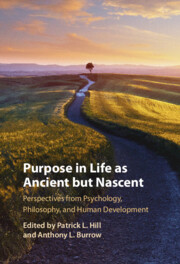 Purpose In Life As Ancient but Nascent
Purpose In Life As Ancient but Nascent Book contents
- Purpose in Life as Ancient but Nascent
- Purpose in Life as Ancient but Nascent
- Copyright page
- Contents
- Figures
- Tables
- Contributors
- Chapter 1 Purpose as an Ancient yet Nascent Construct
- Chapter 2 The Moral Purpose of Wisdom
- Chapter 3 Is Purpose Findable?
- Chapter 4 The Affluence–Purpose Paradox
- Chapter 5 Positive Transitions to Adulthood
- Chapter 6 Undergraduate Students’ Purpose and Persistence in Higher Education
- Chapter 7 How Institutions of Higher Education Support and Thwart Students’ Negotiations of Identity and Self-Direction
- Chapter 8 How to Cultivate Sense of Purpose and Life Engagement
- Chapter 9 You Live, You Learn
- Chapter 10 Seizing the Power of Religion to Shape Purpose
- Chapter 11 Religious Faith and Life Purpose
- Chapter 12 Where Does Purpose Belong in Well-Being Theory?
- Chapter 13 Self-Compassion and Ikigai
- Chapter 14 Purpose as a Timeless Pursuit
- Index
- References
Chapter 6 - Undergraduate Students’ Purpose and Persistence in Higher Education
Published online by Cambridge University Press: 31 October 2025
- Purpose in Life as Ancient but Nascent
- Purpose in Life as Ancient but Nascent
- Copyright page
- Contents
- Figures
- Tables
- Contributors
- Chapter 1 Purpose as an Ancient yet Nascent Construct
- Chapter 2 The Moral Purpose of Wisdom
- Chapter 3 Is Purpose Findable?
- Chapter 4 The Affluence–Purpose Paradox
- Chapter 5 Positive Transitions to Adulthood
- Chapter 6 Undergraduate Students’ Purpose and Persistence in Higher Education
- Chapter 7 How Institutions of Higher Education Support and Thwart Students’ Negotiations of Identity and Self-Direction
- Chapter 8 How to Cultivate Sense of Purpose and Life Engagement
- Chapter 9 You Live, You Learn
- Chapter 10 Seizing the Power of Religion to Shape Purpose
- Chapter 11 Religious Faith and Life Purpose
- Chapter 12 Where Does Purpose Belong in Well-Being Theory?
- Chapter 13 Self-Compassion and Ikigai
- Chapter 14 Purpose as a Timeless Pursuit
- Index
- References
Summary
This chapter explores how undergraduate students’ purpose and motivation for attending postsecondary education contribute to their retention, persistence, and graduation. As a lens for understanding these dynamics, this chapter provides an overview of the Interdisciplinary Theory of College Student Success, which posits that students ask several key questions that determine whether they stay in higher education; one of those questions pertains to their purpose for pursuing a degree and remaining at their current institution. According to this framework, there is not a single “best” type of purpose, since students have different motivations that can drive them to persist in the face of challenges and setbacks. The theory also highlights the role of educational intentions as a key driver of college decision-making. This chapter then discusses research that has directly explored students’ purposes for attending college, which often suggests that the development of purpose and educational intentions are informed by students’ identities and socialization.
Information
- Type
- Chapter
- Information
- Purpose In Life As Ancient but NascentPerspectives from Psychology, Philosophy, and Human Development, pp. 107 - 129Publisher: Cambridge University PressPrint publication year: 2025
References
Accessibility standard: WCAG 2.2 AAA
Why this information is here
This section outlines the accessibility features of this content - including support for screen readers, full keyboard navigation and high-contrast display options. This may not be relevant for you.Accessibility Information
Content Navigation
Allows you to navigate directly to chapters, sections, or non‐text items through a linked table of contents, reducing the need for extensive scrolling.
Provides an interactive index, letting you go straight to where a term or subject appears in the text without manual searching.
Reading Order & Textual Equivalents
You will encounter all content (including footnotes, captions, etc.) in a clear, sequential flow, making it easier to follow with assistive tools like screen readers.
You get concise descriptions (for images, charts, or media clips), ensuring you do not miss crucial information when visual or audio elements are not accessible.
You get more than just short alt text: you have comprehensive text equivalents, transcripts, captions, or audio descriptions for substantial non‐text content, which is especially helpful for complex visuals or multimedia.
You can access graphs or charts in a text or tabular format, so you are not excluded if you cannot process visual displays.
Visual Accessibility
You will still understand key ideas or prompts without relying solely on colour, which is especially helpful if you have colour vision deficiencies.
You benefit from high‐contrast text, which improves legibility if you have low vision or if you are reading in less‐than‐ideal lighting conditions.